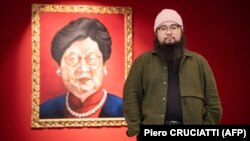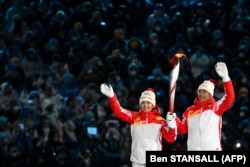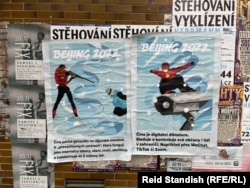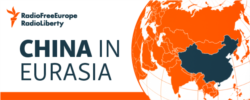
Though Russian President Vladimir Putin and Chinese leader Xi Jinping declared having a “no limits” partnership at a meeting in Beijing on February 4, the Kremlin's massive military buildup around Ukraine and threat to invade is testing Moscow-Beijing ties.
Driven by a shared interest in confronting the United States, Moscow-Beijing relations are the closest since the early days of the Cold War.
The escalating Ukraine crisis, however, has now left China in a difficult bind, balancing its ties with Russia against its established foreign policy of defending state sovereignty and not jeopardizing its long-term strategic interests in Europe and beyond.
“The Chinese still have their lines in the sand,” Jakub Jakobowski of Warsaw's Center for Eastern Studies told RFE/RL. “Anything that could turn Ukraine into a wider military conflict is something that China absolutely does not want.”
As the crisis in Eastern Europe has evolved, with Russia massing more than 150,000 troops along Ukraine’s border, Beijing has tried to walk a fine line: blaming NATO expansion for provoking tensions and criticizing the United States for aggravating the situation, while also calling for greater diplomacy as the prospect of a Russian invasion increases.
Following Putin’s recognition of the separatist entities of Donetsk and Luhansk as independent countries and a Russian commitment to deploy troops there, China’s tightrope act has continued, with Beijing striking a balance between not endorsing Moscow’s latest moves in Ukraine while also not explicitly opposing them.
This more nuanced position was on display during a February 22 call between Chinese Foreign Minister Wang Yi and U.S. Secretary of State Antony Blinken, in which Wang urged all parties involved to “exercise restraint” and resolve the crisis through negotiations. Yet he still gave a nod toward what he viewed as Russia’s legitimate “security concerns.”
“This is a test for this new stage of their relationship that was outlined when Xi and Putin met on the sidelines of the Olympics [on February 4],” Jakobowski said. “And so far, it looks like it is a test that they will pass.”
Walking The Line
Beijing has long said that noninterference and respect for territorial integrity form the backbone of its foreign policy, with China citing these aspects when deflecting criticism of its efforts to gain more control or even crack down in Hong Kong, Taiwan, Tibet, or its western Xinjiang Province.
The growing crisis in Ukraine is also not so clear-cut for Xi’s government.
While Beijing is eager to safeguard its strong relationship with Moscow, it also has long-standing, friendly ties with Kyiv. China is Ukraine’s top trading partner and the country remains a vital gateway for the Belt and Road Initiative (BRI), Xi’s signature geopolitical project.
China is also hoping to minimize wider spillover from Moscow’s moves in Ukraine, such as further derailing Beijing’s currently strained ties with the European Union, avoiding blowback from Western economic sanctions on Russia, and preventing its tense relationship with Washington from becoming even more confrontational.
Zhang Xin, a professor at the Center for Russian Studies at Shanghai’s East China Normal University, said this puts Beijing in an “awkward position” moving forward as it looks to move between these competing interests.
“The overall tone coming from official Chinese statements is an effort to [preserve] normal relations with all parties, including with Ukraine, as much as possible,” Zhang told RFE/RL.
Zhang said he does not expect Beijing to issue any statements judging Russia’s actions in Ukraine, but that it is also unlikely for the Chinese government to show explicit support or take any steps toward recognizing Donetsk and Luhansk as independent countries.
This balancing act is not new for Beijing.
Following Moscow’s illegal annexation of Ukraine's Crimean Peninsula in 2014, China signed a $400 billion gas deal with the Kremlin and embarked on a path of warming ties with Russia. China, however, abstained in a United Nations General Assembly vote about the status of Crimea and still does not recognize the peninsula as part of Russia.
While the China-Russia relationship has improved since 2014, Zhang said war in Ukraine could still cause strain between Beijing and Moscow.
“A lot depends on what happens next in Ukraine,” he said. “Will there be a [full-scale] invasion of Ukraine or perhaps a wider regional conflict? Those are major factors that could change the structure of their ties.”
Mapping A Partnership
China’s state-run media, meanwhile, has been less measured.
Many outlets have pointed to alleged American provocation in fueling the crisis and been supportive in justifying the Kremlin's military maneuvers, with a February 22 editorial from the state-run Global Times saying that U.S. attempts to contain Moscow “finally forced Russia to try to realize its security demands in such a way.”
In a more instructive example, Horizon News, a subset of the Chinese Communist Party's Beijing News, appeared to accidentally post instructions on February 22 about how to cover the escalating tensions in Ukraine on the popular Chinese social media site Weibo.
The message, which has since been deleted, stated that any content painting Russia unfavorably or that took pro-Western framing would not be published.
This rhetoric has also begun to be adopted by some Chinese officials, with Chinese Foreign Ministry spokeswoman Hua Chunying tweeting on February 23 that U.S.-led NATO expansion is to blame for the current crisis in Ukraine.
“Did the [United States] ever think about the consequence of pushing a big country to the wall?” she wrote, in reference to Russia.
Beijing may not love what is taking place, but they won’t stop the Kremlin.”-- Raffaello Pantucci, London's Royal United Services Institute
While Beijing is indeed moving cautiously, Raffaello Pantucci of London's Royal United Services Institute said the Ukraine crisis is unlikely to derail China and Russia’s close ties.
“Beijing may not love what is taking place, but they won’t stop the Kremlin,” he said. “That’s really what this partnership is about at the end of the day. [China and Russia] look for opportunities together, but the biggest part of their new dynamic is simply just trying to not get in each other’s way.”
Worsening ties with the United States also make the partnership with Russia even more critical to China.
During the February 22 phone call with Blinken, Wang also criticized Washington’s new strategy that names China as the main regional concern in the Indo-Pacific region. Wang said this focus on “competition and containment” by American officials was “likely to evolve into full-scale confrontation between China and the United States.”
“If you’re China or Russia and you know that one of the other great powers will not get in your way and sometimes work with you, then that’s a pretty good place to be,” Pantucci said.


















